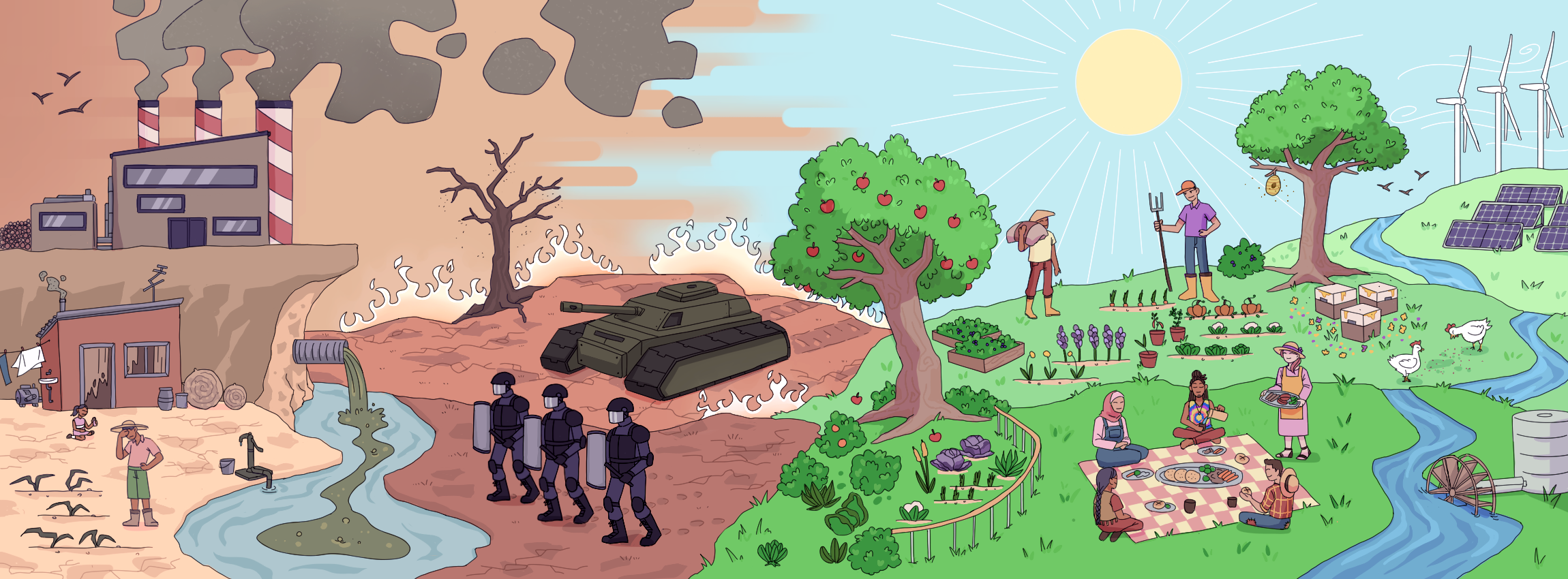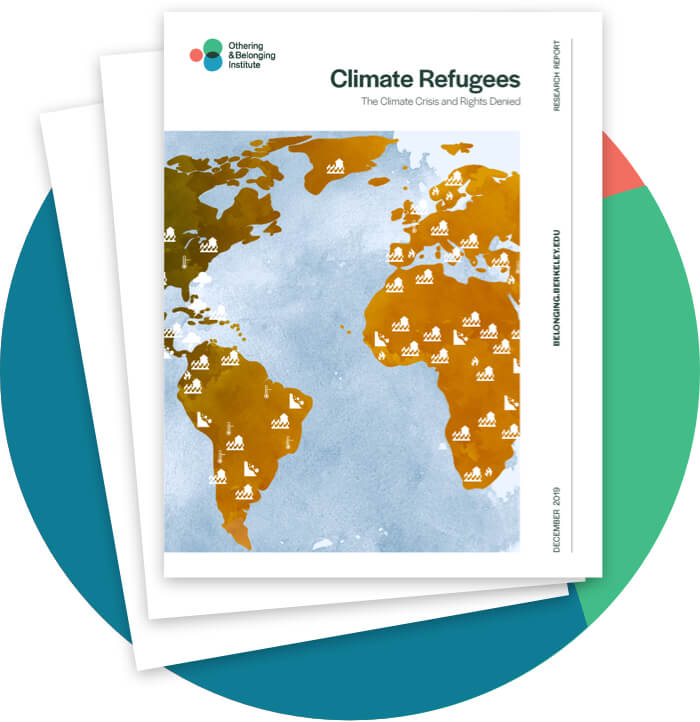Chile
Introduction to Chile
Chile is the sixth most populous country in South America.1 Its population of 19.5 million is about 25% rural. Due to Chile’s unique geography, it houses a wide array of climates and environments, including the Atacama Desert in the north, the Andes mountains in the east, coastal regions in the west, and an Antarctic region in the south.2 Most of the Chilean population resides in Central Chile, which is characterized by a Mediterranean climate,3 and which is very susceptible to natural disasters like drought and wildfires that are intensified by the climate crisis. Chile’s main economic exports are copper, fruit, fish, and wood, while Chilean agriculture remains one of the most undeveloped sectors of the economy despite land reforms across the 20th century.4 The country’s rich supply of natural resources like copper motivated Spanish colonization in the 16th century. This colonial legacy in Chile as well as industrialization and neoliberalization in mid- and late-twentieth century, respectively, has resulted in the displacement and marginalization of Chile’s Indigenous communities, and the intensified precarity they face under the climate crisis.
Mapping Major Climate Events and Climate-Induced Displacement
Chile is ranked as the 29th most climate vulnerable country, being extremely susceptible to geological hazards like earthquakes, tsunamis, and volcanic activity and climate hazards like floods, wildfires, and droughts.5 Between 2010 and 2020, 55 people have been recorded to be killed and 4.2 million were affected by natural disasters.6 The area between Santiago and Puerto Montt has been most susceptible to fires, while the southern and central area is most affected by drought.7 Women and children seem to be affected disproportionately by climate events and agriculture, which employs 9% of the Chilean population, is the industrial sector that suffers the most from drought and natural disasters.8 For example, the 2010-2018 “mega-drought” was the latest and longest in a series of droughts that has affected Central Chile. 81.2% of the country’s population and most of the agricultural sector is found in this region so the drought has had detrimental effects, as seen today in water availability, vegetation, and the recent surplus of forest fires.9 10 In 2021, 2,500 people were displaced in total in Chile due to recent climate events, predominantly floods and wildfires. By the end of the year, 1,400 remained displaced.11 Additionally, Chile is also a major site of refuge for about 450 thousand Venezuelan refugees and asylum-seekers.12
Mapping the Costs of the Climate Crisis
The GDP of Chile is currently $317.06 billion.13 Chile is a major industrial power in Latin America and its key industries include mining, manufactured products, and agriculture.14 After the installation of a military dictatorship in 1973-1990 by Augusto Pinochet, Chile has established a democratic government; however, issues that emerged during the dictatorship persist today as economic inequality, economic insecurity, and a lack of quality public goods remain a big source of hardship and frustration for many Chileans.15 The climate crisis only serves to worsen this inequality and lack of access to public goods. Over the course of three decades, Chile experienced an average of 1.2% GDP loss due to natural disasters.6 Agriculture is the sector of industry most affected, with fruit crops, which make up 31% of Chilean food exports, being at higher risk and facing a decrease of income by $208 million.16 Additionally, drought creates water insecurity for many rural Chileans, since most water is relegated to industrial sectors like agriculture and forestry while only 2% of water is designated for consumption.17
Mapping Resilience and Mitigation Pathways
Chile’s NDC outlines a commitment to reducing CO2 emissions per GDP unit by up to 30-45% below 2007 levels by 2030.18 Chile, notably, has a target to decrease black carbon emissions by 25%, which would mitigate Chile’s contributions to the climate crisis while also eliminating health risks which disproportionately affect poorer communities.19 Additionally, Chile’s mitigation strategy, seen in projects and investments given to the Land-Use, Land Use Change, and Forestry (LULUCF) sector, also focuses on restoring forestry to act as a carbon sink and improving water security.20 Chile’s monitoring and quantification program, HuellaChile, has been working well and serves as an example for other Latin American countries.21 Chile’s revised NDC also places a significant emphasis on a transition to a circular economy which optimizes the store and flow of resources, energy and waste.22 Chile has created the Territorio Circular agency to implement these measures, including the creation of green jobs, the encouragement of recycling, and land recovery.23 The Chilean government has made no mention of mitigation or adaptation strategies to handle and prevent climate migration, something the International Organization for Migration (IOM) has attempted to change.24
Necessary Changes
Chile has already made strong strides towards climate mitigation, showing great commitment to their emissions and black carbon reduction goals. The government has also taken many efforts towards streamlining disaster management and mitigating the impacts of natural hazards like droughts and wildfires.25 Now, it is necessary for the country and international community to take this a step further. Climate-induced migration is a key issue that many Chileans face currently and the government has made no commitments to supporting migrants and mitigating this displacement. Additionally, the influx of Venezuelan asylum-seekers amplifies this pressing refugee crisis. The nation could address this issue by offering displaced people temporary housing or investing in the climate resilience of particularly vulnerable regions. Furthermore, copper and lithium mining, which make up the majority of the Chilean economy, are incredibly energy-intensive and. Thus, Chile and the international community must transition to renewable energy sources while limiting the amount of required lithium mining, in part by reducing the car dependence of the transportation system, decreasing the size of electric vehicle batteries, and maximizing lithium recycling.26 The Chilean indigenous community, while constantly marginalized, should be amplified and centered in Chile’s climate action as they possess a wealth of knowledge about climate adaptation and are most vulnerable to the effects of the crisis.27 Internationally-backed adaptation and mitigation efforts should support the work already being done on the ground to ensure that affected workers’ voices are amplified in the process of just transition, and also help bolster the participation of directly impacted local communities in decision-making. Through this collaborative approach of capacity building for climate action, Chile’s movement towards climate mitigation and resilience can also be sustained and expanded.
Citations
- 1The World Bank. “Population, total.” Accessed February 21, 2023. https://data.worldbank.org/indicator/SP.POP.TOTL?end=2017&most_recent_v….
- 2Climate Change Knowledge Portal. “Chile– Climatology.” Accessed February 21, 2023. https://climateknowledgeportal.worldbank.org/country/chile/climate-data….
- 3Center For Excellence In Disaster Management & Humanitarian Assistance. “Chile: Disaster Management Reference Handbook [DMRH].” https://reliefweb.int/report/chile/disaster-management-reference-handbo… 12, 26.
- 4Congressional Research Service. “Chile: An Overview.” https://sgp.fas.org/crs/row/IF10880.pdf 1.
- 5World Bank Group. “Climate Risk Country Profile: Chile.” https://reliefweb.int/report/chile/climate-risk-country-profile-chile 11.
- 6 a b ReliefWeb. “Disaster Management Reference Handbook - Chile (September 2021).” Accessed February 21, 2023. https://reliefweb.int/report/chile/disaster-management-reference-handbo….
- 7Climate Change Knowledge Portal. “Chile– Vulnerability.” Accessed February 21, 2023. https://climateknowledgeportal.worldbank.org/country/chile/vulnerability.
- 8“Climate Risk Country Profile” 15-16.
- 9Aldunce, Paulina, Dámare Araya, R. Sapiain, Issa Ramos, Gloria Lillo, Anahí Urquiza, and René D. Garreaud. “Local Perception of Drought Impacts in a Changing Climate: The Mega-Drought in Central Chile.” Sustainability 9, no. 11 (November 10, 2017): 2053. https://doi.org/10.3390/su9112053.
- 10Garreaud, René D., Juan Pablo Boisier, Roberto Rondanelli, Aldo Montecinos, Héctor H. Sepúlveda, and Daniel Veloso-Aguila. “The Central Chile Mega Drought (2010–2018): A Climate Dynamics Perspective.” International Journal of Climatology 40, no. 1 (December 31, 2019): 421–39. https://doi.org/10.1002/joc.6219.
- 11Internal Displacement Monitoring Centre. “Global Internal Displacement Database – 2021 Internal Displacement.” Accessed February 21, 2023. https://www.internal-displacement.org/database/displacement-data.
- 12Migration Policy Institute. “Chile’s Welcoming Approach to Immigrants Cools as Numbers Rise.” Accessed February 21, 2022 https://www.migrationpolicy.org/article/chile-immigrants-rising-numbers.
- 13The World Bank. “GDP (current US$) - Chile.” Accessed February 21, 2023 https://data.worldbank.org/indicator/NY.GDP.MKTP.CD?end=2021&locations=….
- 14Santander Trade. “Chile: Economic and Political Outline.” Accessed February 21, 2023 https://santandertrade.com/en/portal/analyse-markets/chile/economic-pol….
- 15“Chile: An Overview.” 1.
- 16Ponce, Roberto Sanz, Maria Blanco, and Carlo Giupponi. “The Economic Impacts of Climate Change on the Chilean Agricultural Sector. A Non-Linear Agricultural Supply Model.” Chilean Journal of Agricultural Research 74, no. 4 (January 11, 2014): 404–12. https://doi.org/10.4067/s0718-58392014000400005.
- 17The Guardian. “‘Consequences will be dire’: Chile’s water crisis is reaching breaking point.” Accessed February 21, 2023. https://www.theguardian.com/world/2022/jun/01/chiles-water-crisis-megad….
- 18United Nations Development Programme. “Chile.” Accessed February 21, 2023. https://www.ndcs.undp.org/content/ndc-support-programme/en/home/our-wor….
- 19Climate & Clean Air Coalition. “Chile increases climate change ambition with targets that simultaneously improve air quality and health.” Accessed, February 21, 2023. https://www.ccacoalition.org/en/news/chile-increases-climate-change-amb….
- 20Gobierno de Chile. “Chile’s Nationally Determined Contribution [NDC].” https://unfccc.int/sites/default/files/NDC/2022-06/Chile%27s_NDC_2020_e… 43, 52.
- 21United Nations Development Programme. “Leaving a Good Footprint in Latin America.” Accessed February 21, 2023. https://www.undp.org/latin-america/blog/leaving-good-footprint-latin-am….
- 22NDC. 49.
- 23Ellen MacArthur Foundation. “Chile’s Circular Economy Roadmap: collaboration for a shared action plan.” Accessed February 23, 2023. https://ellenmacarthurfoundation.org/circular-examples/chiles-circular-….
- 24International Organization for Migration – Mission in Chile. “Migration, Environment And Climate Change.” https://chile.iom.int/sites/g/files/tmzbdl906/files/documents/folleto1_… 2.
- 25DMRH. 37-51.
- 26Climate and Community Project. “Achieving Zero Emissions with More Mobility and Less Mining.” Accessed February 23, 2023. https://www.climateandcommunity.org/more-mobility-less-mining.
- 27COP 25 Chile. “Members Of The Chilean Indigenous Caucus Explored The Different Challenges And Visions To Address Climate Change Integrating Their Cosmovision And Knowledge.” Accessed February 21, 2023. https://cop25.mma.gob.cl/en/members-of-the-chilean-indigenous-caucus-ex….


